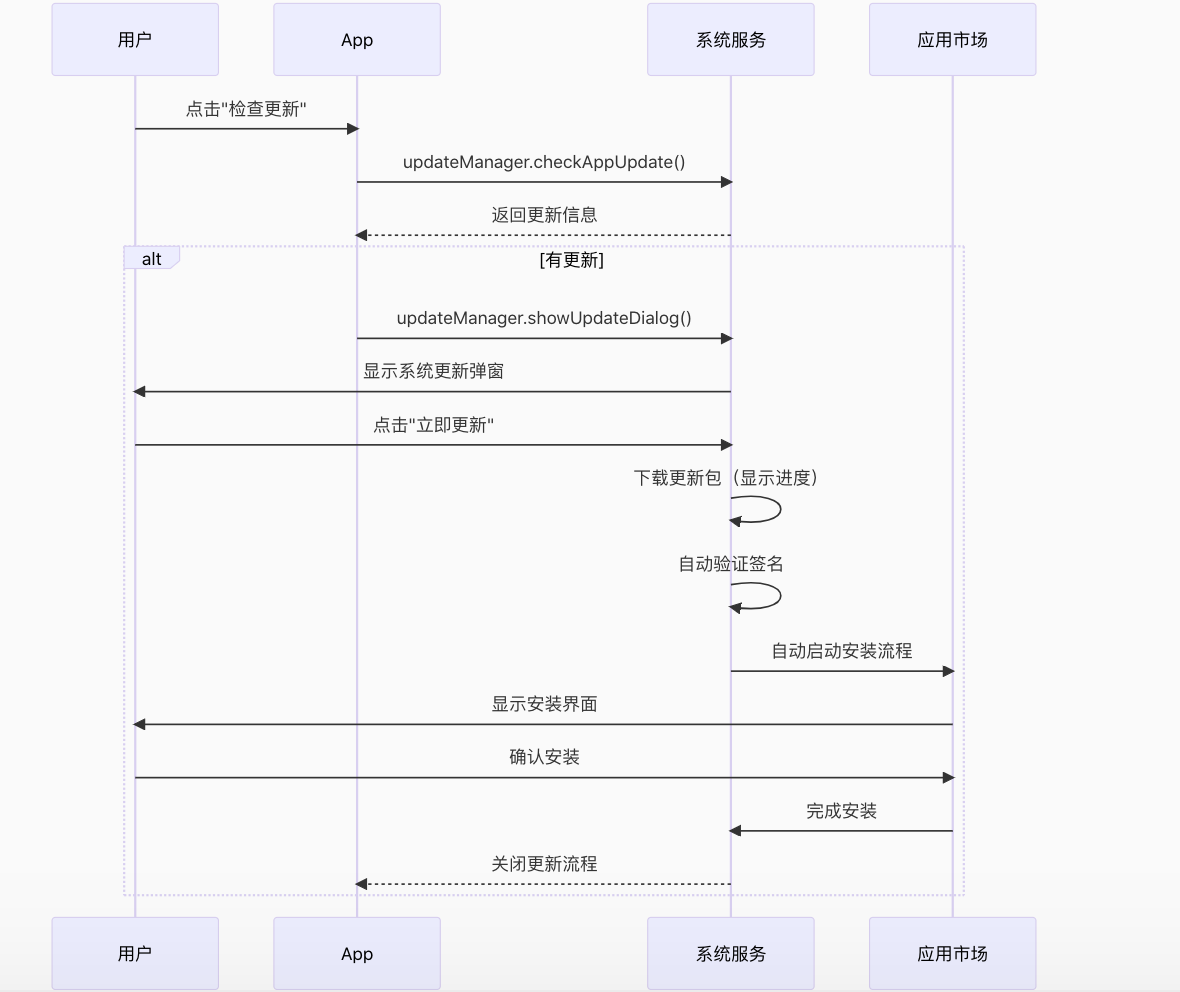本文同步发表于我的微信公众号,微信搜索 程语新视界 即可关注,每个工作日都有文章更新
鸿蒙开发中,通过 updateManager 模块实现的更新功能会在下载完成后自动触发安装流程,这与自定义 OTA 方式不同。
一、updateManager 的安装流程(自动安装)
1. updateManager 更新流程

2. 关键特性
- 无需额外权限:不需要
INSTALL_BUNDLE权限 - 自动处理下载和安装:系统完成所有步骤
- 跳转到应用市场:安装过程在应用市场进行
- 标准化流程:用户体验统一
3. 示例代码
import updateManager from '@ohos.updateManager';
import common from '@ohos.app.ability.common';
@Entry
@Component
struct UpdatePage {
@State message: string = '点击检查更新';
private context: common.UIAbilityContext = getContext(this) as common.UIAbilityContext;
// 检查更新
async checkUpdate() {
try {
this.message = '检查更新中...';
const result = await updateManager.checkAppUpdate(this.context);
if (result.hasUpdate) {
this.message = `发现新版本 ${result.newVersion}`;
// 显示系统更新弹窗
await updateManager.showUpdateDialog(this.context);
} else {
this.message = '已是最新版本';
}
} catch (error) {
this.message = `更新失败: ${error.message}`;
console.error('检查更新出错:', error);
}
}
build() {
Column() {
Text(this.message)
.fontSize(20)
.margin(20)
Button('检查更新')
.onClick(() => this.checkUpdate())
.width('60%')
.height(50)
}
.width('100%')
.height('100%')
.justifyContent(FlexAlign.Center)
}
}二、自定义 OTA 安装方式(手动安装)
与传统 OTA 方式的对比
| 特性 | updateManager | 自定义 OTA |
|---|---|---|
| 安装权限 | 无需 | 需要 INSTALL_BUNDLE 权限 |
| 安装位置 | 应用市场 | 应用内直接安装 |
| 用户交互 | 跳转到应用市场 | 应用内完成所有流程 |
| 流程控制 | 系统控制 | 开发者完全控制 |
| 适用场景 | 应用市场分发 | 企业内部分发/热更新 |
自定义 OTA 安装实现
import installer from '@ohos.bundle.installer';
import fs from '@ohos.file.fs';
import abilityAccessCtrl from '@ohos.abilityAccessCtrl';
class CustomOtaInstaller {
async installHap(hapPath: string) {
const context = getContext();
// 1. 检查文件是否存在
if (!fs.accessSync(hapPath)) {
throw new Error('HAP文件不存在');
}
// 2. 请求安装权限
if (!await this.requestInstallPermission()) {
throw new Error('用户拒绝安装权限');
}
// 3. 执行安装
const bundleInstaller = await installer.getBundleInstaller();
const installParam = {
installFlag: installer.InstallFlag.REPLACE_EXISTING,
userId: 100
};
return new Promise<void>((resolve, reject) => {
bundleInstaller.install(hapPath, installParam, (err) => {
if (err) {
reject(new Error(`安装失败 [${err.code}]: ${err.message}`));
} else {
resolve();
}
});
});
}
// 请求安装权限
private async requestInstallPermission(): Promise<boolean> {
const atManager = abilityAccessCtrl.createAtManager();
try {
const grantStatus = await atManager.requestPermissionsFromUser(
getContext(),
['ohos.permission.INSTALL_BUNDLE']
);
return grantStatus.authResults[0] === abilityAccessCtrl.GrantStatus.PERMISSION_GRANTED;
} catch (err) {
console.error('权限请求失败:', err);
return false;
}
}
}
// 使用示例
@Component
struct OtaInstallDemo {
private installer = new CustomOtaInstaller();
async installUpdate() {
const hapPath = '/data/storage/el2/base/cache/update.hap';
try {
await this.installer.installHap(hapPath);
console.log('安装成功!');
// 提示用户重启应用
AlertDialog.show({ message: '安装成功,请重启应用' });
} catch (error) {
console.error('安装失败:', error.message);
AlertDialog.show({ message: `安装失败: ${error.message}` });
}
}
build() {
Button('安装更新')
.onClick(() => this.installUpdate())
}
}三、混合解决示例(推荐)
结合两种方式的优势:
import updateManager from '@ohos.updateManager';
import installer from '@ohos.bundle.installer';
class SmartUpdater {
async smartUpdate() {
const context = getContext();
try {
// 1. 首先尝试使用系统更新
const hasSystemUpdate = await updateManager.checkAppUpdate(context);
if (hasSystemUpdate) {
await updateManager.showUpdateDialog(context);
return;
}
// 2. 系统无更新,检查自定义更新
const hasCustomUpdate = await this.checkCustomUpdate();
if (hasCustomUpdate) {
await this.installCustomUpdate();
}
} catch (error) {
console.error('智能更新失败:', error);
}
}
private async checkCustomUpdate(): Promise<boolean> {
// 自定义更新检查逻辑
const serverUrl = 'https://your-update-server.com/check-update';
const response = await fetch(serverUrl);
const data = await response.json();
return data.hasUpdate;
}
private async installCustomUpdate() {
// 下载并安装自定义更新包
const hapPath = await this.downloadUpdatePackage();
await this.installHap(hapPath);
}
private async installHap(hapPath: string) {
// 同上文自定义安装逻辑
}
}四、两种方式的区别
1. 权限管理
updateManager:
// 无需声明安装权限自定义OTA:
// module.json5
"requestPermissions": [
{
"name": "ohos.permission.INSTALL_BUNDLE",
"reason": "用于应用内更新"
}
]2. 安装触发方式
updateManager:
// 系统自动触发安装
await updateManager.showUpdateDialog(context);自定义OTA:
// 需要手动调用安装
bundleInstaller.install(hapPath, installParam, callback);3. 错误处理对比
updateManager 错误处理:
try {
await updateManager.showUpdateDialog(context);
} catch (error) {
// 系统级错误代码
if (error.code === 18000001) {
console.error('网络不可用');
}
}自定义OTA 错误处理:
bundleInstaller.install(hapPath, installParam, (err) => {
if (err) {
switch (err.code) {
case 201:
console.error('安装包不存在');
break;
case 202:
console.error('安装包验证失败');
break;
// ...其他错误代码
}
}
});五、企业级实现
1. 安全增强方案
class SecureInstaller {
async safeInstall(hapPath: string) {
// 1. 验证签名
const isValid = await this.verifySignature(hapPath);
if (!isValid) throw new Error('签名验证失败');
// 2. 检查包名匹配
const packageInfo = await this.extractPackageInfo(hapPath);
if (packageInfo.bundleName !== getBundleName()) {
throw new Error('包名不匹配');
}
// 3. 执行安装
return this.installHap(hapPath);
}
private async verifySignature(hapPath: string): Promise<boolean> {
// 实现签名验证逻辑
return true;
}
}2. 安装后验证
async function verifyAfterInstall() {
const bundleManager = bundle.getBundleManager();
const bundleName = getBundleName();
const bundleInfo = await bundleManager.getBundleInfo(bundleName, 0);
const installedVersion = bundleInfo.versionName;
// 比对安装的版本是否符合预期
if (installedVersion !== expectedVersion) {
throw new Error('版本验证失败');
}
// 检查签名证书
const certValid = verifyCertificate(bundleInfo.signature);
if (!certValid) {
throw new Error('证书验证失败');
}
}3. 用户体验优化
@Component
struct UpdateProgressView {
@State progress: number = 0;
@State status: string = '准备中';
build() {
Column() {
Text(this.status)
.fontSize(18)
Progress({ value: this.progress, total: 100 })
.width('80%')
.margin(20)
if (this.status.includes('失败')) {
Button('重试')
.onClick(() => this.startUpdate())
}
}
}
}总结
-
updateManager 方式:
- 下载后自动跳转到应用市场安装
- 无需处理安装权限和细节
- 标准化流程,用户体验一致
- 适合通过应用市场分发的标准应用
-
自定义 OTA 方式:
- 应用内直接完成安装
- 需要申请安装权限
- 完全控制安装流程
- 适合企业内部分发或特殊场景
-
选择建议:
- 优先使用
updateManager标准更新流程 - 特殊需求(如企业内部分发)使用自定义 OTA
- 大型应用可结合两种方式实现混合更新
- 优先使用
在实际开发中,推荐使用官方的 updateManager 作为首选方案,除非有特殊需求才考虑自定义 OTA 安装方案。




















 481
481

 被折叠的 条评论
为什么被折叠?
被折叠的 条评论
为什么被折叠?








